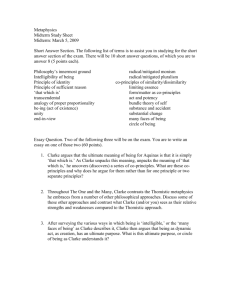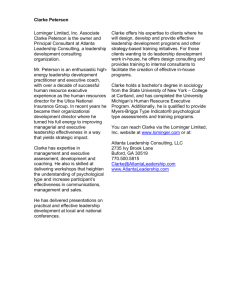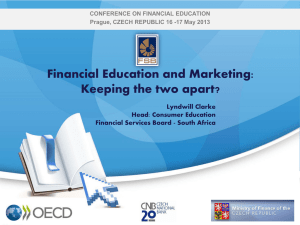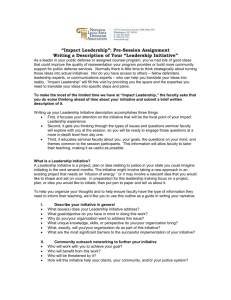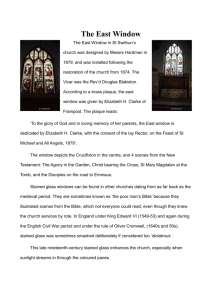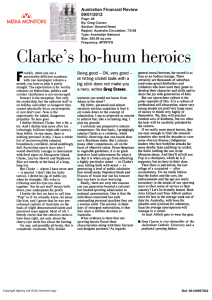Systemic Semiotic Design Practice:
advertisement
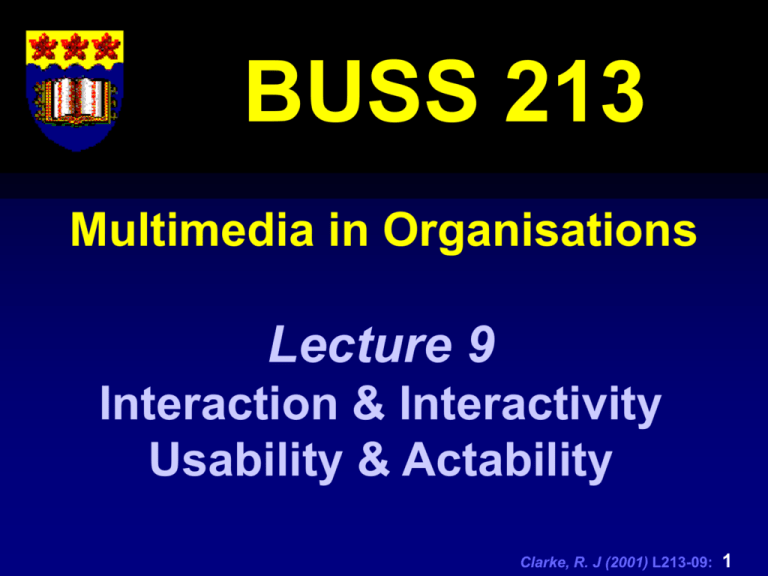
BUSS 213 Multimedia in Organisations Lecture 9 Interaction & Interactivity Usability & Actability Clarke, R. J (2001) L213-09: 1 Notices (1) Announcements If you are a BCom student who is close to finishing your degree there is an Honours Information Session being held by the Department of Information Systems, October 8 12:30-1:30 in the Function Rooms, Unicentre Clarke, R. J (2001) L213-09: 2 Notices (2) Submission of Assignment 2 Assignment 2 is due today however we have extended the time. You may now submit by 5:30pm rather than the previously advertised 10:30pm. this enables you to finalise your assignment, and also enables your tutor to explain how to submit your files unless space is available, only students enrolled in particular tutorials will be allowed into a given tutorial class class rolls may be called and will be strictly enforced if necessary Clarke, R. J (2001) L213-09: 3 Notices (3) General Notices Due to a time extension on Assignment 2 no formal tutorial file will be available this week Make sure you have a copy of the BUSS213 Subject Outline and Please check the class roll on the Departmental Notice Board or on my door for your allocated tutorial slot BUSS213 is supported by a website, where you can find out the latest Notices and get Lecture Notes, Tutorial Sheets, Assignments etc www.uow.edu.au/~rclarke/buss213/buss213.htm Clarke, R. J (2001) L213-09: 4 Agenda so far we have examined media in isolation and in combination, we have looked at multimedia systems from the point of view of the interfaces they present to users and modelling the applications that sit behind the interface you will recall that in the first lectures we claimed that multimedia systems are different to other traditional systems… …now we draw our attention back to the user again to consider those aspects of multimedia systems which are absent from conventional systems that use multiple media they include: Interaction and Interactivity Usability and Actability Clarke, R. J (2001) L213-09: 5 Interaction & Interactivity Clarke, R. J (2001) L213-09: 6 Degrees of Interactivity interactivity is an extremely difficult concept to grasp, yet it appears to be central to any definition of multimedia- we tend to know it when we have it interactivity is a kind of defining characteristic which separates multimedia from other types of systems or systems which utilise multiple media in the apparent absence of a theory of interactivity from within the field of organisational multimedia, we turn in stead to traditional education and pedagogic applications of multimedia and see what insights this theory can provide (if any) Clarke, R. J (2001) L213-09: 7 Interaction & Interactivity Windows 2000 Explorer with Thumbnail view selected- is an application that supports multiple media – but is not a multimedia system as with most aspects of user interface design and multimedia systems in particular, surprising little is known about the nature of interaction and interactivity we must be able to understand these issues because… …they are central to understanding the differences between conventional information systems that display information in the form of collections of multiple media versus multimedia systems Clarke, R. J (2001) L213-09: 8 Interaction & Interactivity interactivity is central to any definition of multimedia it is arguably the most crucial means by which other systems supporting multiple media can be distinguished from multimedia systems there are several ways in which interactivity can be understood- a long standing way of understanding interactivity is by theorising it from an education psychology (learning theory) approach Clarke, R. J (2001) L213-09: 9 Show OnSite 3.0 demo Clarke, R. J (2001) L213-09: 10 Interaction & Interactivity the images opposite are from the OnSite! 3.0 training CD-ROM developed by CEDIR at UoW for the construction industry the top most image is the opening screen which uses an office metaphor as a kind of generalised desktop metaphor various courses are available by clicking the filing cabinet shown in the bottom sequence of images OnSite! contains a range of learning resources for building and construction workers, trainees, apprentices and students. It is flexible, interactive and engaging, with a mix of text, illustration, animation and video material Clarke, R. J (2001) L213-09: 11 Degrees of Interactivity Clarke, R. J (2001) L213-09: 12 Degrees of Interactivity interactivity is an extremely difficult concept to grasp, yet it appears to be central to any definition of multimedia- we tend to know it when we have it interactivity is a kind of defining characteristic which separates multimedia from other types of systems or systems which utilise multiple media in the apparent absence of a theory of interactivity from within the field of organisational multimedia, we turn in stead to traditional education and pedagogic applications of multimedia and see what insights this theory can provide (if any) Clarke, R. J (2001) L213-09: 13 Degrees of Interactivity Categories of Educational Software presentation drill tutorial database expert system intelligent tutor performance support system hypermedia model emulation simulation microworld adventure role play virtual reality Presumed Complexity: how much control is provided to the learner and how much interactivity from an information systems point of view do you see anything wrong with this kind of typology Clarke, R. J (2001) L213-09: 14 Degrees of Interactivity Categories of Educational Software this kind of continuum of educational software is dubious but is certain is that these kinds of educational software have been developed within certain kinds of cognitive theory: socratic dialogue behaviourism fragmentism experiential learning constructivism metacognition Bawden’s (1992) types of learning Propositional- being Told Practical- being Shown Experiential- transforming our own experiences Clarke, R. J (2001) L213-09: 15 Degrees of Interactivity Pedagogic Dimensions of Educational S/W… pedagogical dimensions include such factors as philosophy, teacher roles, and learner control each pedagogic dimension can be represented as a continuum with a more or less specified range of values most interactive learning systems are described in terms of many dimensions, the dimensions proposed are not comprehensive of mutually exclusive Clarke, R. J (2001) L213-09: 16 Degrees of Interactivity …Pedagogic Dimensions of Educational S/W Epistemology Pedagogic Philosophy Underlying Psychology Goal Orientation Instructional Sequencing Experiential Value Role of Instructor Value of Errors Motivation Structure Accom. Ind. Differences Learner Control User Activity Co-operative Learning Objectivism vs Constructivism Instructivist vs Constructivist Behavioural vs Cognitive Sharply-focused vs Unfocused Reductionist vs Constructivist Abstract vs Concrete Teacher-proof vs Egalitarian Facilitator Errorless learning vs Learning from Experience Extrinsic vs Intrinsic High vs Low Non-existent vs Multi-faceted Non-existent vs Unrestricted Mathemagenic vs Generative Unsupported vs Integral Clarke, R. J (2001) L213-09: 17 Degrees of Interactivity Traditional Design (after Sims 1991) Introduction Present Information Question & Response Feedback & Remediation Judge Response Summary based on behavioural psychology using a fact-questionfeedback model reflects educational theories of Socrates and Skinner useful for basic skills training- interactivity at a very low level Clarke, R. J (2001) L213-09: 18 Degrees of Interactivity Information Systems Design (after Sims 1991) high degree of learner control as learners are free to browse in whichever direction they wish & find information when necessary there is no instruction, assessment and judgement compared to educational software learning theory encompasses neural networks, fragmentism and constructivism Introduction Topic A Topic B Topic C Topic D Clarke, R. J (2001) L213-09: 19 Degrees of Interactivity Hypermedia Design (after Sims 1991) related to e so-called information systems design is hypermedia design in which additional hyperlinked structures are superimposed over the top of the hierarchical structure of topics provided by the information systems design model reminds one of web sites! Oz Introduction & Main Menu Oz Oz Topic A Oz Topic B Oz Topic C Oz Topic D Oz Clarke, R. J (2001) L213-09: 20 Degrees of Interactivity Experiential Learning (after Sims 1991) Introduction Present Learning Environment Allow Student Interactions System Update Judge Response Access Knowledge Base avoids judgement includes simulations and role plays present learners/users with a learning environment instead of presenting them with information an attempt to contrive a contexts in which the fact scan make sense built onto of an information system or a knowledge base Summary Clarke, R. J (2001) L213-09: 21 Degrees of Interactivity Critique of Pedagogic Classifications these kinds of classification schemes are based on contingencies (in this case dimensions) they are not based on any particular theory of interaction- remember that this type of (psychological) theory was demonstrated as problematic for organisational multimedia because it tends to preclude the social Clarke, R. J (2001) L213-09: 22 Interactivity as Engagement (1) Wells (1996) is correct when she says that interactivity is engagement rather than point and click (but interestingly you do not need educational theory to come to this conclusion) the notion of interactivity goes beyond free-range browsing, beyond providing learner control (read user control) Bender in Laurel (1991) defines engagement as… Clarke, R. J (2001) L213-09: 23 Interactivity as Engagement (2) Engagement…is similar in many ways to the theatrical notion of the willing suspension of disbelief, a concept introduced by the early nineteenth century critic and poet Samuel Taylor Coleridge. It is the state of mind that we must attain in order to enjoy a representation of an action. Coleridge believed that any idiot could see that a play on stage was not real life… Coleridge noticed that, in order to enjoy a play, we must temporarily suspend (or attenuate) our knowledge that it is pretend. (Laurel 1991, 113) Clarke, R. J (2001) L213-09: 24 Interactivity as Engagement (3) “The kinds of information we receive from our surroundings are quite varied. and have different effects upon us. We obtain raw, direct information in the process of interacting with the situations we encounter. …Processed, digested, abstracted secondhand knowledge is often more generalised and concentrated but usually effects only intellectuallylacking the balance and completeness of experienced situations… Information communicated as facts loses all its contexts and relationships, while information communicated as art or as experience maintains and nourishes its connections” (Bender in Laurel 1991, 119) Clarke, R. J (2001) L213-09: 25 Interactivity as Engagement (4) Bender’s observations have been supported quite persuasively by the multimedia revolution in computerbased educational activities. Likewise, educational simulations (as opposed to tutorial and drill-and-practice forms) excel in that they represent experience as opposed to information. Learning through direct experience has, in many contexts, been demonstrated to be more effective and enjoyable than learning through ‘information communicated as facts’. Direct multi-sensory representations have the capacity to engage people intellectually as well as emotionally, to enhance the contextual aspects of information, and to encourage integrated, holistic responses” (Laurel 1991, 119) Clarke, R. J (2001) L213-09: 26 Interaction Typology Clarke, R. J (2001) L213-09: 27 Interaction Typology Flexible Media and Media Spaces some years back Clarke (1997) won a small CEDIR grant to examine the theory behind a proposal I had developed called flexible media and media spaces this proposal was developed in response to educational developments on campus referred to as ‘flexible delivery’- this debate which been raging on this campus for at least 5 years, is a consequence of the expansion of university courses to different sites (Nowra, Bega, Dubai) and the need to provide the delivery of educational services to many places at once Clarke, R. J (2001) L213-09: 28 Interaction Typology Debates concerning ‘Flexible Delivery’ to illustrate some of the different views or positions surrounding the term ‘flexible delivery’: flexible delivery is the same as distance education!- in which case it represents nothing new- an old concept in new clothes flexible delivery is the educational use of ‘new technologies’ for example, PowerPoint slides shows and web sites for onand off-campus subjects- its therefore simply a phenomenon defined by technology having no enduring value flexible delivery is simply a way of casualisation of academics by forcing them to teach off-campus as part of there basic contracts- this demonstrates the social nature of multimedia flexible delivery is something qualitatively different- this was my position- it was an opportunity to rethink how we create and use media objects Clarke, R. J (2001) L213-09: 29 Interaction Typology Multimedia with many kinds of Interaction my ‘solution’ was to propose (multi)media objects which support different types and levels of interactivity in effect this solution to the question of what is flexible delivery is to propose that every unit of content- every media object should support more than one kinds of interaction in effect the same flexible media behaves differently in different usage contexts well of course I never got to implement any of these media objects because I ran out of time and money but some of the ideas are interesting and suggestive of ways we can extend object orientation beyond multimedia development to include multimedia deployment and use … these ideas rely on an interaction typology Clarke, R. J (2001) L213-09: 30 Interaction Typology Flexible Media and Media Spaces flexible media consists of multimedia objects which form media resources or components (Clarke 1997) if we were talking about an educational application of flexible media then each component describes or illustrates a single concept or group of independent concepts these components are arranged within a media space which forms a multimedia framework and a context of use for the flexible media Clarke, R. J (2001) L213-09: 31 Interaction Typology Hypothetical Example … an individual component might consist of a digital video sequence showing a workplace while a subsequent component might describe the concept of a system boundary depending on the order in which these objects is arranged in the media space the system boundary component might be applied to the workplace component in order to show the system boundary of the workplace Clarke, R. J (2001) L213-09: 32 Interaction Typology … Hypothetical Example … in principle the arrangement of flexible media components within a media space is arbitrary (no specific arrangement is required apriori) however, the actual arrangement of flexible media units is specific to the kind of application the media space is supporting- for example, in teaching contexts the arrangement of flexible media attempts to model the specific curricula Clarke, R. J (2001) L213-09: 33 Interaction Typology … Hypothetical Example … B b1 b2 a3 a2 a4 a1 a5 A diagram shows flexible media consisting of two separate groups of components, A and B Component group A consists of specific components a1, a2, … a5, while component group B consists of specific components b1 and b2 Clarke, R. J (2001) L213-09: 34 Interaction Typology … Hypothetical Example … B b1 b2 a2 a3 a4 a1 a5 a2 A a1 a4 Users Viewplane Group A is closer to the users viewpoint and therefore its components will appear larger on the screen that those of Group B. Note that component a1 occludes (that is blocks) component a3- the user literally cannot see a3 prior to interacting with the media a5 a5 Clarke, R. J (2001) L213-09: 35 Interaction Typology … Hypothetical Example the interface to such a system might be reminiscent of the interfaces we looked at from MIT these interfaces were developed by Lisa Strausfeld to provide a volumetric representation of a sample portfolio of seven separate mutual funds but they could be adapted to display flexible media in media spaces Clarke, R. J (2001) L213-09: 36 Interaction Typology … Hypothetical Example … the point however is that each of these flexible media objects supports a set of different interactions or modes of use in principle, flexible media in should exhibit some dynamic behaviour- the space comprising flexible media objects should be similar to seeing a set of interesting stories in a newspaper- each one competing for the users immediate attention three levels of interaction were identified… Clarke, R. J (2001) L213-09: 37 Interaction Typology Zero-level & Low-level Interaction zero-level interaction: is referred to as the ‘rest-state’ of the media what it does when it is not being directly manipulated by the user flexible media are intended to cycle through a number of steps which are designed to show off their major features low-level interaction: initiating or triggering a particular designed state Clarke, R. J (2001) L213-09: 38 Interaction Typology Example: Zero- & Low-level Interaction in fact the BHP CD-ROM, the digital video template used the concept of combining zero- and low-level interaction within the same interface component a default video sequence played unless the user selected an alternative view of the action Clarke, R. J (2001) L213-09: 39 Interaction Typology High-level Interaction high-level interaction were media components communicate with each other- message passing in the objectoriented view and change each others state similar to the example of a workplace clip and a boundary flexible media object interacting with each other (polymorphism) Clarke, R. J (2001) L213-09: 40 So far… we do not yet have a theory of interactivity- it would seem that interactivity is very difficult to define there are however some interesting ideas in the educational multimedia literature that we have investigated, these include: the inadequacy of information- a users experience is not necessarily completely in response to information and multimedia systems do not simply provide information the importance of context- although so far we do not have a theory of context interactivity involves not just media and what it does, but users and what they need to do Clarke, R. J (2001) L213-09: 41 Contextual Theory of Interaction Clarke, R. J (2001) L213-09: 42 Contextual Theory of Interaction we need to describe two things: what it is possible for a user to select- to describe the range of options they have available to them at a given point in time- this is given a special name paradigmatic dimension to describe the actual options and sequences of options that they do select- this is given a special name it is called the syntagmatic dimension Clarke, R. J (2001) L213-09: 43 Paradigms as Field Taxonomies User Interfaces and System Networks One way we can describe what is possible - the realm of the paradigmatic dimensionis to gather information in the form of a so-called field taxonomies this idea comes from linguistics but it is a very neat way of describing any set of options- just like those found in user interfaces in order to build a field taxonomy of the user interface we use a special graphical notation called a system network Clarke, R. J (2001) L213-09: 44 Paradigms as Field Taxonomies Least Delicate and Most Delicate Options system networks are read from left hand side, the so-called least delicate, to the right hand side, the so-called most delicate the following diagrams show the four major notations used and are based on Broman (1994, 80 modified after Eggins 1994, 205206; Halliday 1991, 43) Clarke, R. J (2001) L213-09: 45 Paradigms as Field Taxonomies Logical OR; Realisation a If the entry condition of x applies, then either a or b must be chosen x b a If the entry condition of x applies, then either a or b must be chosen. b is realised by p. x b p Figure G1: Graphical notation (right) and an explanation of their meanings (left) used in system networks. The networks should be read from left (least delicate) to right (most delicate). Diagram after Broman 1994, 80 (modified after Eggins 1994, 205206; Halliday 1991, 43) a If the entry condition of x applies, then either a or b must be chosen x b a If the entry condition of x applies, then either a or b must be chosen. b is realised by p. x b p a b If the entry condition of x applies, then either a or b and either c or d. x c d 'go' 'stop' Recursive system: If the choice is 'go' then we are in an iterative process whether either 'go' or 'stop' can be chosen again. This iterative process goes on until the choice 'stop' is made Clarke, R. J (2001) L213-09: 46 a If the entry condition of x applies, then either a or b must be chosen. b is realised by p. x Paradigms as Field Taxonomies b Logical AND; Recursion p a b If the entry condition of x applies, then either a or b and either c or d. x c d 'go' 'stop' Recursive system: If the choice is 'go' then we are in an iterative process whether either 'go' or 'stop' can be chosen again. This iterative process goes on until the choice 'stop' is made Figure G1: Graphical notation (right) and an explanation of their meanings (left) used in system networks. The networks should be read from left (least delicate) to right (most delicate). Diagram after Broman 1994, 80 (modified after Eggins 1994, 205206; Halliday 1991, 43) a If the entry condition of x applies, then either a or b must be chosen x b a If the entry condition of x applies, then either a or b must be chosen. b is realised by p. x b p a b If the entry condition of x applies, then either a or b and either c or d. x c d 'go' 'stop' Recursive system: If the choice is 'go' then we are in an iterative process whether either 'go' or 'stop' can be chosen again. This iterative process goes on until the choice 'stop' is made Clarke, R. J (2001) L213-09: 47 Microsoft PowerPoint Interface File, Edit, View, Insert and Format Submenus Clarke, R. J (2001) L213-09: 48 Field Taxonomy for part of Microsoft PowerPoint interface Clarke, R. J (2001) L213-09: 49 Contextual Theory of Interaction there are several interesting things about field taxonomies and systems networks: they reveal a very powerful idea implicit in paradigms that is directly applicable to user interface design that the choices that users make constrain the kinds of actions that they can subsequently do also we can describe the specific set of options that they take through the network – their usage syntagm Clarke, R. J (2001) L213-09: 50 Contextual Theory of Interaction unlike the kind of educational pedagogic theory we described earlier which is based on psychology and therefore by definition has a very hard time bridging the gap between the individual and the social… …a contextual theory of interaction has no problems with describing what users do because we now have an understanding of the choices they can possible make these field taxonomies (represented in system networks) are social resources for meaning making- and so this level of description is highly appropriate in organisational contexts Clarke, R. J (2001) L213-09: 51 Usability Clarke, R. J (2001) L213-09: 52 Typical Usability Laboratories these are one of the most commonly available ways of determining whether software is useful or not SINTEF Usability Lab (Oslo) Clarke, R. J (2001) L213-09: 53 Sun’s Usability Lab Clarke, R. J (2001) L213-09: 54 Formal, experimental usability testing Rapid turnaround user interface development and testing Observation of small group meetings with or without a technology or communications component “Touch and try" prototype and product evaluations Swinburne Computer Human Interaction Laboratory (SCHIL) Clarke, R. J (2001) L213-09: 55 Usability Laboratories the User Room within the Department’s own Usability Laboratory is instrumented so that what is being typed and what is occurring in the room is recorded many facilities also trap the output of the system into a form known as a keystroke transcript which can be analysed latter to view repeating patterns which may signal poor interface design or inefficient use of the software ATUL Usability Laboratory: Users Room Department of Information Systems, University of Wollongong Clarke, R. J (2001) L213-09: 56 Usability Laboratories ATUL Usability Laboratory: Observers Room Department of Information Systems, University of Wollongong Clarke, R. J (2001) L213-09: 57 Conclusions Clarke, R. J (2001) L213-09: 58 Conclusions Interactivity is an illusive aspect of multimedia- point and click does not equal interactivity Educational and pedagogic applications of multimedia cannot bridge the gap between the individual and social and there cannot explain interface use from a social (read organisation) perspective an organisationally relevant theory of interactivity must be contextual, and must relate the use of an interface to particular groups in organisations we describe a contextual theory of user interfaces which allows permits developers to document and analyse interfaces using the dual concepts of paradigms and syntagms Clarke, R. J (2001) L213-09: 59 Readings Clarke, R. J. (1997) Media Space: Representation and Implementation” CEDIR Grant, Centre for Educational Development and Interactive Resources, University of Wollongong Dede. C. (1995) “The Transformation of Distance Education to Distributed Learning” (Online) http://www.hbg.psu.edu/bsed/intro/doc/distlearn/ July 1995 Gaines, B. R. & M. L. Shaw (1995) “Concept Maps as Hypermedia Cpomponents” http://ksi.cpsc.ucalgary.ca/articles/ConceptMaps/CM.html, November 1995, 5pp. Laurel, B. (1991) Computers as Theatre Addison-Wesley Clarke, R. J (2001) L213-09: 60 Readings Reeves, T. (1992) Effective Dimensions of Interactive Learning Systems in ITTE 92 Information Technology in Training and Education University of Queensland, 1992, pp. 99-115 Wills, S. (1996a) “Beyond Browsing: Making Interactive Multimedia Interactive” Educational Media Services, University of Wollongong Reprint 96/004 Wills, S. (1996) “Interface to interactivity: Technologies and techniques” Educational Media Services, University of Wollongong Reprint 96/003 Wills, S. and R. Swart (1996) “The book is dead, long live the book: Designing interactive publications” Educational Media Services, University of Wollongong Reprint 96/012 Clarke, R. J (2001) L213-09: 61
